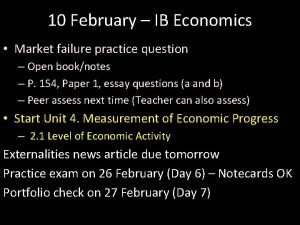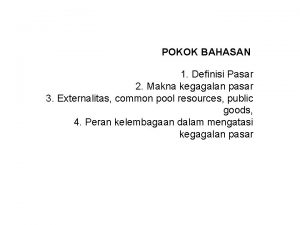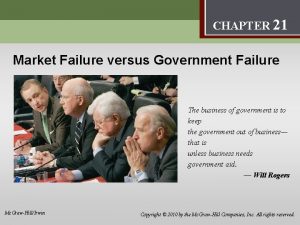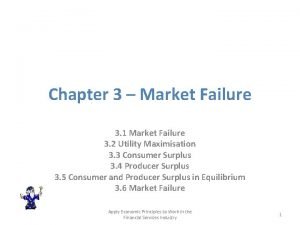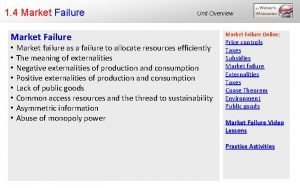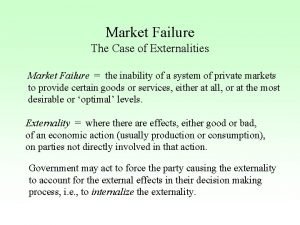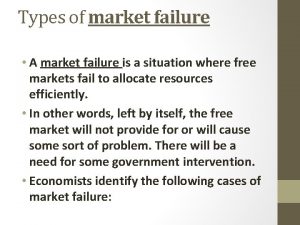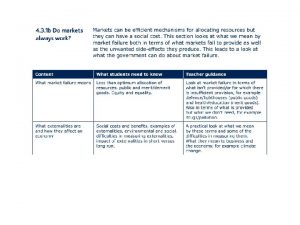JUSTICE AND THE MARKET or MARKET FAILURE vs
















- Slides: 16

JUSTICE AND THE MARKET or MARKET FAILURE vs. JUDGEMENT FAILURE by Menahem Yaari 2017

A page from a book called “THE SEEKER”, by the Spanish-Jewish scholar Shemtov Ibn-Falquera, written in the year 1263: 2

The Story 2 persons – Alice and Bob – sit down to eat; Alice has 3 loaves of bread, Bob has 2 loaves; A third person (“The Guest”) walks by, and is invited to join them. All 3 sit down to have a meal together; When the meal is over, the guest puts down 5 Dinars, saying “Divide this money between you fairly”, and leaves; Alice says: 3 Dinars for me, 2 for you; Bob says: 2 -and-a-half Dinars for me, 2 -and-a-half for you; They go before a judge; The Judge: 4 Dinars for Alice, 1 Dinar for Bob. 3

Alice’s division (3 -2) implements Aristotle’s proportionality principle Bob’s division (2½- 2½) implements the contractual rights principle The Judge’s division (4 -1) implements the competitive markets principle 4

The Proportionality Principle “… a just act necessarily involves at least four terms: two persons for whom it is in fact just, and two shares in which justice is exhibited. And there will be the same equality between the shares as between the persons, because the shares will be in the same ratio to one another as the persons; ” Aristotle, Ethics, Book V (iii) “… justice that is distributive of common property is always in accordance with the proportion that we have described above (because if the distribution is made from common funds it will be in the same ratio as the corresponding contributions bear to one another)” Aristotle, Ethics, Book V (iv) 5

The Contractual Rights Principle Two persons, A and B, go to court over the possession of a certain desirable and divisible object P. Person A presents the court with a legally valid claim (contractual right) to P in its entirety. Person B presents the court with a legally valid claim to one half of the object P. Judgment: A and B shall receive ¾ and ¼ shares in P, respectively. The Talmud, Torts, Middle Gate, Ch. 1 (Only a generally recognized contractual right – e. g. A’s right to one half of P – can justify departure from equality. ) 6

The Competitive Markets Principle In dividing a commonly owned object (an asset, a bundle of goods, etc. ) among a number of agents, regard the agents as traders in a competitive (equal-access) market, calculate the corresponding competitive allocation, and distribute the object accordingly. (In the “SEEKER” story, we imagine the guest purchasing the bread from Alice and Bob in a competitive market. Assuming the diners are equally hungry (each one eating 5/3 loaves of bread) we find that the guest buys 4/3 loaves from Alice and 1/3 from Bob. In a competitive market prices are fixed and equal, so the amount paid to Alice is 4 times the amount paid to Bob. ) 7

QUESTION 1 A shipment containing 12 grapefruit and 12 avocados is to be distributed to Alice and Bob. The following facts are given, and are known also to Alice and Bob themselves: • Doctors have determined that Alice’s metabolism is such that her body derives 100 mg Vitamin C from each grapefruit, but from avocados her body derives no vitamins whatsoever. • Doctors have determined that Bob’s metabolism is such that his body derives 50 mg Vitamin C from each grapefruit and also from each avocado. • Alice and Bob are interested in consuming grapefruit and/or avocados only inasmuch as this consumption provides their bodies with Vitamin C, and the more Vitamin C the better. All the other traits of these fruits (such as their taste, or other nutrients that they may contain) are irrelevant for them. • Once the fruits are divided, no trades can take place between Alice and Bob. How should the fruits be divided, if the division is to be just? 8

QUESTION 2 A shipment containing 12 grapefruit and 12 avocados is to be distributed to Alice and Bob. The following facts are given, and are known also to Alice and Bob themselves: • Alice loves grapefruit, and she would buy quite a few of them, as long as their price does not exceed $10 per kilogram. She hates avocados and never buys any of them. • Bob likes grapefruit and avocados equally well and would buy both of them indifferently, as long as their prices do not exceed $5 per kilogram. • Alice and Bob are in the same income tax bracket. • Once the fruits are divided, no trades can take place between Alice and Bob. How should the fruits be divided, if the division is to be just? 9

QUESTION 3 A shipment containing 12 grapefruit and 12 avocados is to be distributed to Alice and Bob. The following facts are given, and are known also to Alice and Bob themselves: • Alice believes that each grapefruit contains 100 mg Vitamin C and that avocados contain no vitamins whatsoever. • Bob believes that each grapefruit, and also each avocado, contains 50 mg Vitamin C. • Alice and Bob are interested in consuming grapefruit and/or avocados only inasmuch as this consumption provides their bodies with Vitamin C, and the more Vitamin C the better. All the other traits of these fruits (such as their taste, or other nutrients that they may contain) are irrelevant for them. • Once the fruits are divided, no trades can take place between Alice and Bob. How should the fruits be divided, if the division is to be just? 10

FIVE CONSPICUOUS DIVISIONS A Alice receives 6 grapefruit and 6 avocados Bob receives 6 grapefruit and 6 avocados B Alice receives 6 grapefruit and 0 avocados Bob receives 6 grapefruit and 12 avocados C Alice receives 8 grapefruit and 0 avocados Bob receives 4 grapefruit and 12 avocados D Alice receives 9 grapefruit and 0 avocados Bob receives 3 grapefruit and 12 avocados E Alice receives 12 grapefruit and 0 avocados Bob receives 0 grapefruit and 12 avocados 11

ENVY- FREE ZONE 12

v. B 1200 B C A 600 0 600 D E 1200 v. A 13

THEORETICALLY SELECTED DIVISIONS Division “Naïve” Equality A The Proportionality Principle C The Contractual Rights Principle B The Competitive Markets Principle E Rawls’s Theory C Utilitarianism E Bargaining (from equal split) D 14

EMPIRICALLY SELECTED DIVISIONS (% of respondents) QUESTION DIVISION 1 2 3 A 8 9 34 B 0 4 4 C 82 28 51 D 8 24 4 E 2 35 7 15

How well does the competitive market conform to people’s judgments of justice? - relatively well in cases of division among individuals who differ in their TASTES - quite poorly in cases of division among individuals who differ in their NEEDS Market Failure? Judgment Failure? 16
 Ventricular escape rhythm
Ventricular escape rhythm Failure to sense vs failure to capture
Failure to sense vs failure to capture Brittle failure vs ductile failure
Brittle failure vs ductile failure Socially optimal quantity positive externality
Socially optimal quantity positive externality Market segmentation lesson
Market segmentation lesson Define market failures
Define market failures Role of government in correcting market failure
Role of government in correcting market failure Market failure definition ib
Market failure definition ib Indirect tax to correct market failure
Indirect tax to correct market failure Government transfer payments examples
Government transfer payments examples Market failure quiz
Market failure quiz Market failures
Market failures Common hazard in market
Common hazard in market Pengertian market failure
Pengertian market failure Market failure examples
Market failure examples Kegagalan pasar adalah
Kegagalan pasar adalah Market leader challenger follower nicher
Market leader challenger follower nicher







